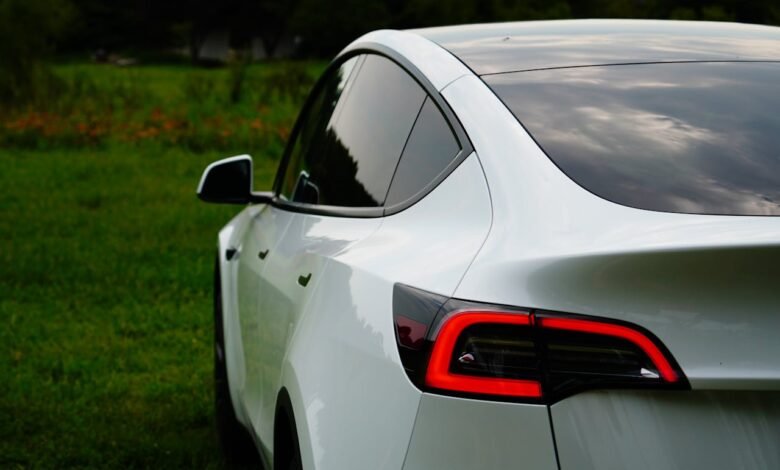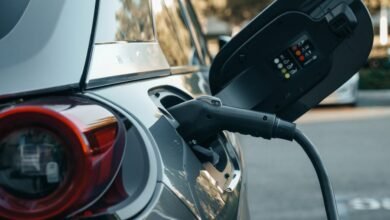The Future of Driving: Exploring the Latest EV Models for 2023

Through 2025, the electric vehicle industry is undergoing a revolution in unprecedented proportions. Whether it is the craze of new battery technologies or the charging solutions that are more advanced, this guide has all the new EVs, the most innovative of them all, and the current trends moving the world of sustainable transport to UK and beyond.
Introduction: Electric Revolution picks up pace
2025 will go down in history as the turning point in the evolution and use of car-related technologies, with the electric vehicle fully becoming an alternative to the standard car. As the UK Zero Emission Vehicle (ZEV) mandate seeks to have 28% of all new car sales be electric in 2030, up enormously on 22% by 2024, auto manufacturers are reacting by pledging a wide range of juicy innovations and advances12.
The trend is clear: UK electric vehicle sales hit an all-time high in 2024, the number of electric cars sold totaled 381,970 or 19.6 percent of all new car registrations3. This trend goes till 2025, and it is estimated that about 20 percent of the new cars in 2025 will be running on electricity4. With a recorded shift in preferences, it is likely that for the first time the conventional petrol and diesel vehicles will have less than 50 percent of the market shares.
Key EV Innovations Defining 2025
Solid-State Battery Revolution
In 2025, the greatest innovation will be the mainstream of solid-state batteries. Such new generation sources of power are safer, charge quicker (with possible charging times being cut in half), and are of greater energy density5. Technological leaders contributing to this revolution are companies such as Toyota and QuantumScape, as these companies hold potential in promising to solve the main concerns that have crippled the EV uptake in the past.
Bidirectional Charging and Vehicle-to-Grid Integration
Vehicle-to-Grid (V2G) technology is transforming EVs from mere transportation devices into mobile energy storage units56. This innovation allows electric vehicles to:
- Store renewable energy and feed it back to the grid during peak demand
- Provide emergency backup power for homes during outages
- Generate cost savings for owners through grid contribution incentives5
Enhanced Autonomous Driving Capabilities
The fourth level of autonomy will become a reality in 2025, and even today, eventually, the EVs can self-drive in all but the most extreme conditions. They can navigate in complex situations and environments securely using computerised AI systems and algorithms of machine learning and an extensive array of sensors which include LiDAR, radar and cameras.
Latest EV Models Hitting the Market
Premium Segment Leaders
Luxury EV segment is enjoying unprecedented growth with a number of high-profile introductions:
MG Cyberster (Experimental July 2025): the convertible is a luxury car with a 443km range and 503 bhp engine, an exciting 77 kWh battery, about 80,000 pounds.
BMW iX3 (Planned Q2 2026): BMW iX3 is based on the new BMW Neue Klasse platform and has an 800-volt architecture, allowing fast charging and features a range of 400 miles (9. Et luxurious pullable energy enterprise positioning (required Q2 2026): Running on a BMW Neue Klasse platform, the iX3 boasts an 800-volt architecture, which will offer super-fast charging capabilities, and will promise a range of 400 miles.
Audi Q6 e-tron (August 2025): Available as an alternative to the luxury SUVs, the car is a further testament of Audi to the best electric mobility.
Mid-Range Market Expansion
The accessible EV segment is experiencing significant growth:
Maruti e Vitara (Expected September 2025): With a projected range of 500km and power options between 142-172 bhp, this model targets the mainstream market with pricing between £17,000-£22,5009.
Hyundai Creta Electric (Expected 2025): Priced at approximately £17,990, this compact SUV demonstrates the increasing affordability of electric mobility11.
Affordable Options
Tata Tiago EV: Starting at £7,990, this represents one of the most accessible electric vehicles, proving that sustainable transportation needn’t be prohibitively expensive11.
MG Comet EV: At £6,170, this ultra-compact option showcases how manufacturers are making EVs accessible to budget-conscious consumers11.
UK Market Dynamics and ZEV Mandate Impact
The UK’s ambitious ZEV mandate is fundamentally reshaping the automotive landscape. Manufacturers are employing two primary strategies to meet the 28% requirement: restricting combustion engine vehicle sales and offering substantial discounts on electric models12.
This regulatory pressure is yielding positive results. October 2024 saw EV sales reach 20.7%, up from 15.6% in 2023, whilst annual BEV sales climbed to 18.1%1. The mandate’s flexibility, allowing plug-in hybrids to count as partial BEVs and enabling credit trading between manufacturers, ensures compliance whilst maintaining market dynamics1.
Technological Breakthroughs Reshaping EVs
Ultra-Fast Charging Technology
Charging infrastructure is experiencing revolutionary improvements. Ultra-fast charging technology now enables EVs to reach 80% capacity in mere minutes, making electric vehicle charging as convenient as traditional refuelling6. The UK has seen a 45% increase in rapid and ultra-rapid public chargers since May 20233.
Wireless Charging Innovation
2025 introduces widespread wireless charging capabilities, allowing EVs to charge simply by parking over a charging pad without physical connectors76. This technology promises to enable dynamic charging along highways, fundamentally changing how we think about vehicle energy management6.
Advanced Materials and Design
Innovative materials including carbon-fibre composites and lightweight alloys are revolutionising EV design. These materials reduce vehicle weight without compromising strength, improving energy efficiency and overall performance6.
Charging Infrastructure Evolution
The UK’s charging network continues expanding rapidly, with Greater London leading infrastructure development with 22,211 public charge points as of early 20253. Home charging remains popular, with typical 7kW chargers fully charging vehicles in approximately eight hours, whilst rapid 50kW chargers can add 100 miles of range in roughly 35 minutes3.
Looking Ahead: What’s Next for Electric Mobility
The integration of solar panels into EV designs represents an exciting frontier for 2025. This technology can supplement battery power, reducing dependence on external charging infrastructure and bringing self-sufficient sustainable transportation closer to reality6.
Artificial intelligence is becoming integral to EV functionality, providing predictive maintenance, real-time navigation optimisation, and advanced driver assistance. These AI-powered systems enhance safety, optimise energy consumption, and create increasingly intelligent vehicles6.
Comparison Table of Top 2025 EV Models
| Model | Price Range | Range (km) | Power (bhp) | Battery (kWh) | Expected Launch |
|---|---|---|---|---|---|
| MG Cyberster8 | £80,000 | 443 | 503 | 77 | July 2025 |
| Maruti e Vitara9 | £17,000-£22,500 | 500 | 142-172 | 49-61 | September 2025 |
| Hyundai Creta Electric11 | £17,990 | – | – | – | 2025 |
| Tata Harrier EV11 | £21,490 | – | – | – | Available |
| Mahindra BE 611 | £18,900 | – | – | – | Available |
| BYD Atto 311 | £24,990 | – | – | – | Available |
| Kia EV611 | £65,970 | 650+ | – | 84 | Available |
| Tata Tiago EV11 | £7,990 | – | – | – | Available |
Frequently Asked Questions
Q: What are the key benefits of solid-state batteries in 2025 EVs?
A: Solid-state batteries offer higher energy density for greater range, faster charging times (potentially half the duration of conventional batteries), and improved safety with reduced overheating risks5.
Q: How does the UK’s ZEV mandate affect EV availability and pricing?
A: The mandate requires 28% of new car sales to be electric in 2025, leading manufacturers to restrict combustion vehicle sales and offer discounts on EVs, making electric vehicles more accessible and affordable12.
Q: What is Vehicle-to-Grid (V2G) technology and why is it important?
A: V2G technology allows EVs to store renewable energy and feed it back to the grid during peak demand, enabling cost savings for owners and supporting grid stability whilst providing emergency backup power56.
Q: How fast can modern EVs charge in 2025?
A: Ultra-fast charging technology can charge EVs to 80% capacity in just a few minutes, whilst rapid 50kW chargers can add 100 miles of range in approximately 35 minutes63.
Q: What autonomous driving capabilities are available in 2025 EVs?
A: Level 4 autonomy is becoming available, allowing EVs to operate autonomously in most conditions without human intervention, using advanced AI and comprehensive sensor systems76.
Q: Are there affordable EV options available in 2025?
A: Yes, models like the Tata Tiago EV (£7,990) and MG Comet EV (£6,170) demonstrate that electric mobility is becoming increasingly accessible across all price segments11.
Q: What role does wireless charging play in the future of EVs?
A: Wireless charging eliminates the need for physical connectors, allowing EVs to charge by simply parking over a charging pad, with potential for dynamic charging along highways in the future76.
Q: How is the UK’s charging infrastructure developing?
A: The UK has seen a 45% increase in rapid and ultra-rapid public chargers since May 2023, with Greater London leading with 22,211 public charge points as of early 20253.
The electric vehicle landscape in 2025 represents a convergence of technological innovation, regulatory support, and consumer acceptance. As we witness the transformation from internal combustion to electric propulsion, the vehicles launching this year will define the next decade of sustainable transportation. With breakthrough technologies, expanding infrastructure, and increasingly affordable options, the future of driving is undoubtedly electric.
